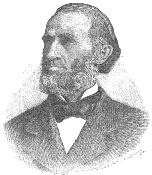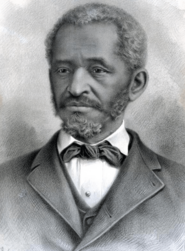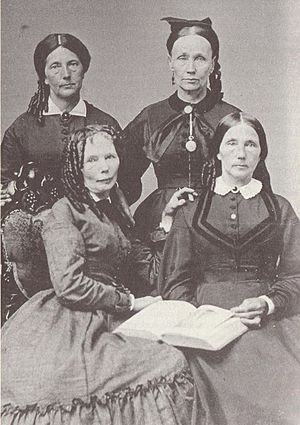Delia Webster facts for kids
Delia Ann Webster (born December 17, 1817 – died January 18, 1904) was an American teacher, writer, and businesswoman. She was a brave abolitionist in Kentucky. An abolitionist is someone who worked to end slavery. Delia Webster, along with Calvin Fairbank, helped many enslaved people escape to freedom. This included Lewis Hayden, his wife Harriet, and their son Joseph. They escaped to Ohio and then to Canada.
Delia was arrested and sentenced to two years in prison for helping the Haydens. But she was pardoned after only two months. In 1854, Webster bought a farm in Trimble County, Kentucky. She got financial help from abolitionists in Boston. She used her farm as a secret stop on the Underground Railroad. The Underground Railroad was a network of safe houses and routes that helped enslaved people escape to free states or Canada.
Delia was arrested a second time for helping freedom seekers. However, the trial was stopped. Soon after, her home and farm were damaged by vandals and set on fire. She lost her farm because she could not pay for repairs or her loan. She then moved to Indiana. In 1996, Delia Webster was honored as one of the Kentucky Women Remembered. A special painting hangs in her honor in the Kentucky Capitol Building.
Contents
Growing Up
Delia Webster was born on December 17, 1817. Her parents were Benajah and Esther Webster. She was one of ten children. They lived in Vergennes, Vermont. Delia went to the Vergennes Classical School. She started teaching school when she was just 12 years old.
Delia grew up near a farm called Rokeby. This farm was a known safe place for travelers on the Underground Railroad. Today, Rokeby is a special national landmark. In 1835, Delia became a teacher. She later went to Oberlin College in Ohio. This college was the first in the United States to accept students of all races. The town of Oberlin was a strong center for abolitionists. Many people there helped enslaved people escape to freedom.
Helping Enslaved People in Kentucky

In 1843, Delia Webster traveled to Lexington, Kentucky. She decided to stay there to teach art. She also helped start the Lexington Female Academy. Delia's work to end slavery in Lexington was very important. People who supported slavery hated and feared her. Even though they couldn't prove anything, they always suspected her. She faced many threats and much trouble.
Despite this, she kept working. She traveled from place to place. She always met with enslaved people. She taught them ways to escape. Often, she helped them directly herself. She often worked with a Methodist minister named Calvin Fairbank. People said that her work was very effective in Northern Kentucky.

In 1844, Delia Webster and Rev. Calvin Fairbank helped three enslaved people escape. These were the Hayden family. They helped them travel by wagon to Ohio. When their role was discovered, Delia and Fairbank were arrested. They had separate trials. Delia was tried and sentenced in 1845. She was sent to the Kentucky Penitentiary. She was accused of helping enslaved people escape.
On February 24, 1845, Governor John J. Crittenden pardoned Delia Webster. The prison warden, Newton B. Craig, asked the governor to do this. To gain her freedom, she said she was not an abolitionist. After her release in February 1845, Delia went to live with her parents. She wrote a book about her experience. It was called Kentucky Jurisprudence: A History of the Trial of Miss Delia A. Webster (1845).
Her Farm: A Safe Stop
After her release, Delia lived with her parents in Vermont for three years. She taught school there. But the cold winters were bad for her health. She then moved to New York. There, she taught school and worked for women's right to vote. She also sought the ocean air for her bronchitis. Because of her health, she returned south. In 1849, she moved to Madison, Indiana. Kentucky was just across the Ohio River from Madison. She worked as a governess for Newton Craig's family for several years. She traveled with them. She even took Craig's son, Dillard, to Vermont and tutored him.
After leaving the Craigs' employment, Delia met with other abolitionists in the east. She returned to Madison, bought a house, and lived there for a year. Then she moved to Trimble County. She began working with the Underground Railroad again in 1853.
In 1854, Delia Webster bought a large 600-acre farm. It was located along the Ohio River in Trimble County, Kentucky. Abolitionists from the North helped her pay for it. She named her farm Mt. Orison. It became an important station on the Underground Railroad. She hired formerly enslaved Black people to work on her farm. Slave owners in Kentucky were angry. They accused her of helping their enslaved people escape. They threatened Delia, her crops, and her farm. Her farm was raided, and she received threats against her life.
In 1854, a warrant was issued for her arrest. This was because enslaved people were missing in the area. She was arrested and put in jail. But she managed to escape. Delia traveled to Madison, Indiana. She hid in many places in the city and country. She was later captured and jailed in Indiana. She faced a trial under the 1850 Fugitive Slave Act. This trial took place in Madison in late July. Newton Craig was a witness against her. On May 21, 1854, Judge Walker released Delia.
Delia's farm had been robbed of about $9,000 worth of belongings. She could not make her loan payments. So, people in the anti-slavery movement from Boston, Massachusetts created a "Webster Farm Association." With their help, she was able to keep her farm. She continued to work with the Underground Railroad. During the Civil War, she also served as a nurse for wounded soldiers. She worked alongside Harriet Beecher Stowe.
Delia had bought materials to build a school on her property. But in November 1866, her home and the building materials were destroyed by arsonists. Arsonists are people who set fires on purpose. Over time, arsonists destroyed seventeen buildings, four barns, and finally Delia's home. Without enough money, she lost her property in October 1869.
Later Life and Legacy
Delia Webster moved back to Madison, Indiana. She returned to teaching. After the Civil War, African American children were not allowed to attend public schools. So, she taught children in a school set up in an African American Baptist Church. She also wrote and gave lectures for a time. Delia Webster died on January 18, 1904, in Iowa. She was living with her niece, Dr. Alice Goodrich, at the time.
A special Kentucky Highway Marker was put up to honor Delia Webster. It calls her the "Petticoat Abolitionist." It is located in Trimble County. The marker tells about her Underground Railroad station. It also mentions her arrests and escapes. There is also a highway marker at the Trimble County jail in Bedford, Kentucky. It states that she was its most famous resident. In 1996, Delia Webster was honored as one of the Kentucky Women Remembered. Her portrait hangs in the West Wing of the Kentucky State Capitol. It is displayed with other important women of Kentucky.
Images for kids



